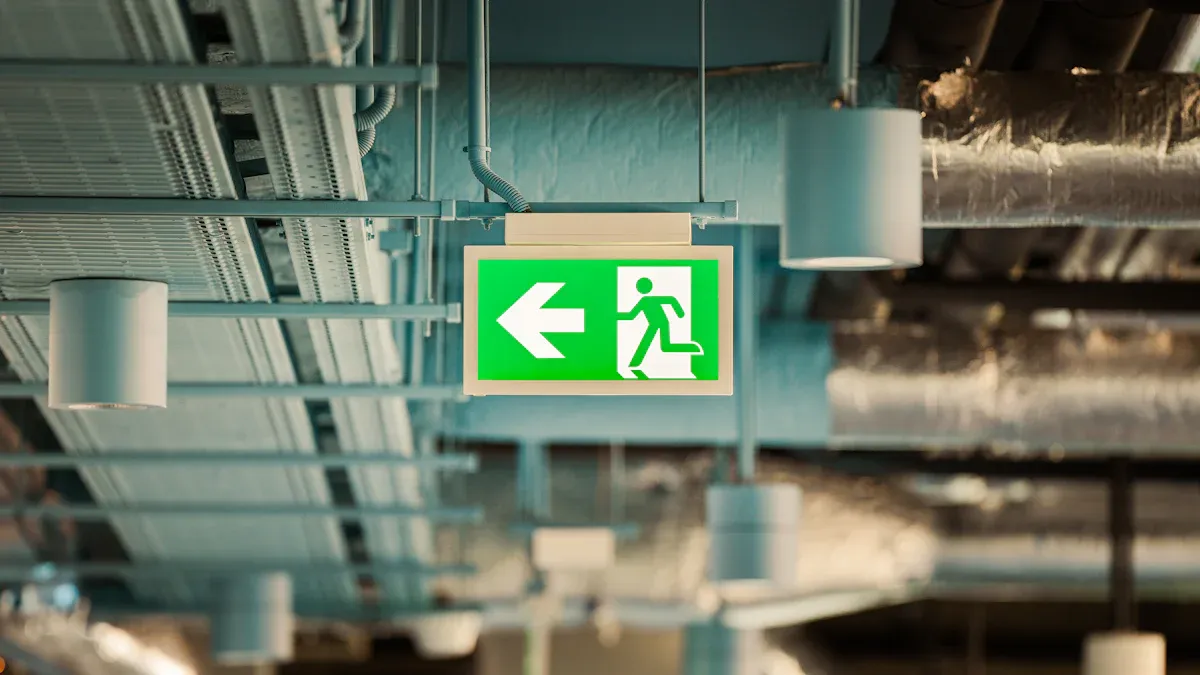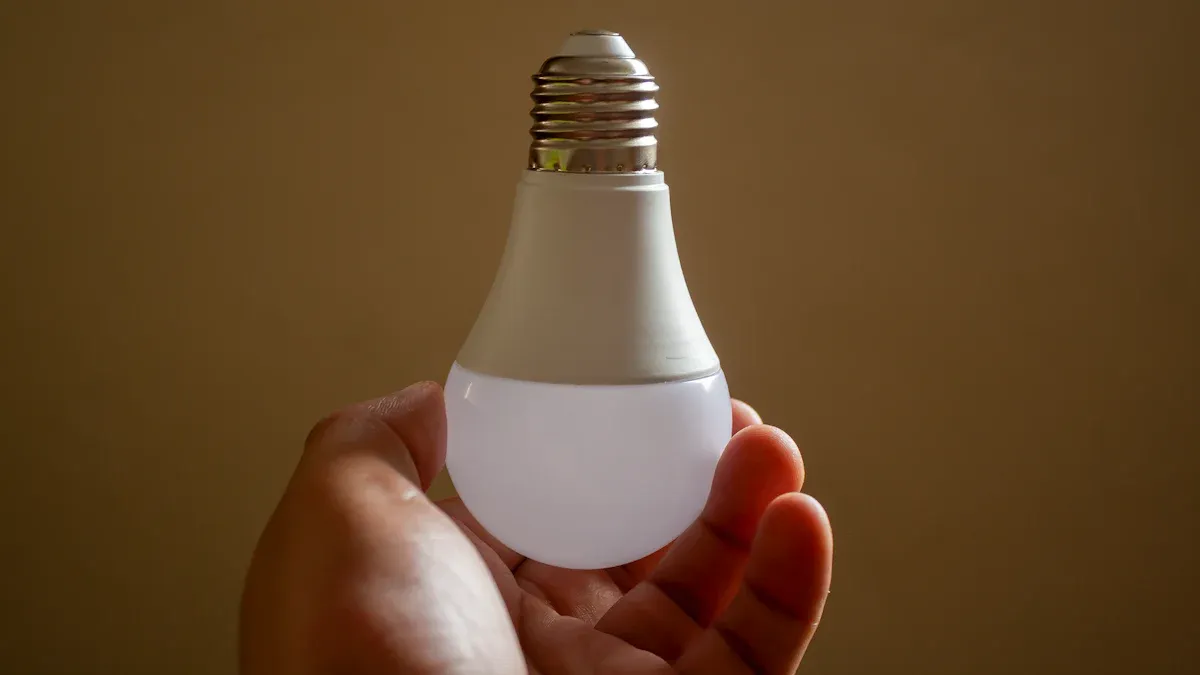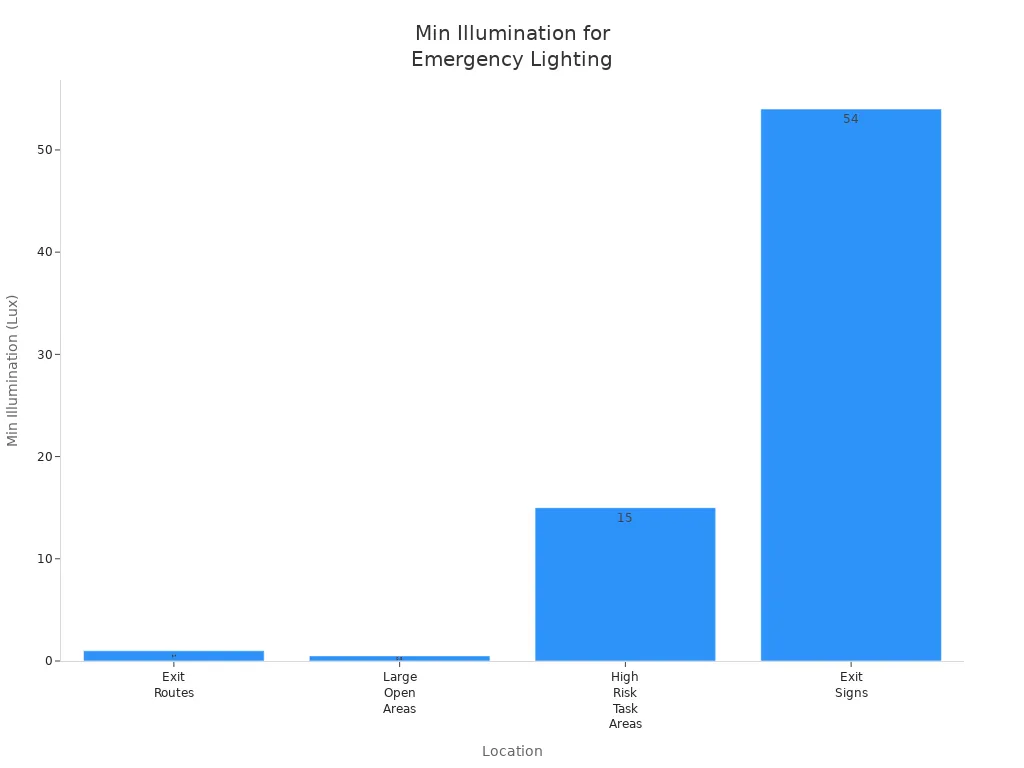White LEDs in Emergency Lighting: Brightness Ratings, Color Temperature, and Selection Guide

When you choose white leds for emergency situations, you make a big decision about safety. Brightness plays a key role because you need to see clearly during a power outage. Lumens show you how much light a bulb gives. A good bulb for indoor lighting or outdoor lighting should have the right color temperature to help you stay alert. At Home, you want every Product to work well, just like you expect from a Solar Light. If you want to learn more, check the About Us page.
Key Takeaways
Pick white LED bulbs with enough brightness (lumens) so people can see well in emergencies. Use cool white light (5000K to 6500K) for emergency lights because it helps people find exits and move safely. Make sure the bulb’s lumens and color temperature fit the size and purpose of each area for good lighting. Choose energy-efficient LEDs that last a long time to save money and need less fixing. Follow safety rules, put in the lights the right way, and test them often to keep emergency lights working well.
Brightness and Lumens

Measuring Lumens
It is important to know about lumens for emergency lighting. Lumens tell you how much visible light comes from a bulb. This helps you know how bright the bulb is. Watts only show how much energy the bulb uses. Lumens show how much light you actually see. For white leds, the lumen number on the box tells you the light output. This makes it easier to compare bulbs and choose the best one for you.
Recommended Lumens for Emergency Lighting
Emergency lighting has to follow safety rules. These rules make sure you have enough light to see and move safely. The table below lists the lowest brightness needed for different places:
Application Area | Minimum Illuminance | Equivalent Lumens | Notes |
|---|---|---|---|
Corridors & Evacuation Routes | 1 lux | N/A | Safe walking and direction |
Exit and Safety Signs | 10-15 lumens | 10-15 lumens | Clear exit sign visibility |
High Risk Areas | 10-20 lux or more | N/A | Emergency response support |
Emergency Lighting Fixtures | N/A | 50 lumens | Basic safe identification |
Tip: Always look at local rules like NFPA 101 or IBC. These rules may say you need at least 1 footcandle (about 10.8 lux) on walkways and at least 50 lumens for emergency lights.
Interpreting LED Brightness
LED bulbs use less power than old bulbs but can be just as bright. For example, a 7-watt LED can shine as much as a 40-watt regular bulb. LEDs also keep their brightness steady for a long time and in hot or cold places. This makes them a good pick for emergency lighting. You get steady light when you really need it.
Color Temperature in White LEDs

Understanding Kelvin Scale
When you look at white leds, you might see a number with a "K" on the box. This number tells you the color temperature. It is measured in Kelvin. The Kelvin scale starts at the coldest point and goes up. If the number is low, like 3000K, the light looks warm and a little brown. A 4000K bulb gives a natural white light with a bit of yellow. If you pick a 5000K bulb, the light is pure white with no color tint. The Kelvin scale helps you know what kind of light you will get. This makes it easier to choose the right kelvin color for your emergency lights.
Best Color Temperature for Emergency Lighting
You want emergency lights to help people see well and feel safe. Safety codes like NFPA 101 say to use cool light between 5000K and 6500K. This range gives a bright, clear light. It helps people see exits and move safely. Cool white light is easy to see in dark or smoky places. That is why most buildings use it for emergency lighting.
Impact on Visibility and Comfort
The color temperature you pick changes how well people see and how safe they feel. Cool white light helps you see details, even when it is dark. It cuts down on shadows and helps you find your way out. Warm white light feels cozy but may not be clear enough in an emergency. Cool white leds help people stay alert and move fast to safety. Putting these lights in the right spots keeps halls, stairs, and exit signs bright. This helps everyone feel safe.
Selecting White LED Bulbs
Assessing Lighting Needs
First, look at the places that need emergency lighting. Each area in a building needs different light levels. Exit routes, big open rooms, high-risk work spots, and exit signs all need their own brightness. The table below shows the lowest light needed for each place:
Location for Emergency Lighting | Minimum Illumination Level (Lux) |
|---|---|
Exit Routes | 1 |
Large Open Areas | 0.5 |
High Risk Task Areas | 15 |
Exit Signs | 54 |
Emergency lighting should also cover first aid spots, phones, areas for disabled people, exit doors, and outside exits. The design must fit your building’s shape and how it is used. Emergency lighting helps everyone see and move safely if there is an emergency.

Tip: Put emergency bulbs near exits, stairs, elevators, and places where people gather. Always make sure the lights work with your building’s power and follow safety rules.
Matching Lumens and Color Temperature
When picking a bulb for emergency lighting, match the lumens and color temperature to the room size and shape. Lumens tell you how much light a bulb gives. Hallways need about 20 lumens for each square foot. Workshops need 50 lumens or more for each square foot. To find out how many lumens you need, multiply the room’s size by the lumens needed for each square foot. Divide this by the light from one bulb to see how many bulbs you need.
Color temperature is important too. Most emergency lights use cool white light between 5000K and 6500K. This gives a bright, clear light that helps people see in dark or smoky places. Some rules say to use 3500K with a CRI of at least 80 for good color. Always check the latest advice from the Illuminating Engineering Society (IES). Make sure your bulbs work with emergency power or battery packs.
Note: Spread the light evenly. Put bulbs so there are no shadows and all escape paths are bright.
Energy Efficiency and Lifespan
Picking bulbs that save energy helps you spend less money and is better for the planet. New white leds for emergency lighting give 100 to 200 lumens for each watt. This is much better than halogen bulbs, which only give 15 to 25 lumens for each watt. The table below compares how well different bulbs use energy:
Lighting Type | Luminous Efficacy (lumens per watt) |
|---|---|
LED Emergency Lights | 100 - 200 |
Halogen Emergency Lights | 15 - 25 |
You also want bulbs that last a long time. White LED bulbs can last 50,000 to 100,000 hours. This means you will not have to change them often or spend much on fixing them. LEDs are also good for outdoor lighting because they can handle bumps, bad weather, and hot or cold days.
Lighting Technology | Typical Lifespan (hours) | Additional Notes |
|---|---|---|
White LED Bulbs | 50,000 - 100,000 | Long lifespan, instant activation, energy efficient |
Halogen Bulbs | 1,000 - 2,000 | Short lifespan, generates heat |
Incandescent Bulbs | ~1,000 | Very short lifespan, less efficient |
Tip: LED bulbs may cost more at first, but they save money over time because they use less energy and last longer. You might also get money back from rebates or special offers.
Compliance and Standards
You must make sure your emergency lighting follows all safety rules and standards. The table below lists some important rules for emergency lighting:
Standard/Certification | Region/Scope | Description/Focus |
|---|---|---|
UL 924 | United States | Safety standard for emergency lighting and power equipment. |
NFPA 101 | United States | Life Safety Code detailing emergency lighting requirements in buildings. |
EN 1838 | Europe | Specifies safety and performance requirements for emergency lighting and evacuation systems. |
IEC 60598-2-22 | International (IEC) | Safety requirements for emergency lighting fixtures including design and testing methods. |
ISO 3864 | International (ISO) | Principles for safety signs and signals, including emergency lighting and evacuation indicators. |
ISO 30061 | International (ISO) | Standard for emergency escape lighting ensuring visibility and safe evacuation. |
CE Marking | European Union | Certification indicating compliance with EU health, safety, and environmental standards. |
CCC Certification | China | Mandatory certification for emergency lighting products sold in China. |
Different buildings have different rules. Offices, warehouses, and stores need emergency lighting for safe exits. Apartment buildings need lights in halls and stairs. Factories need strong systems for dangerous areas. Hospitals and schools have extra rules because they help people who need more care. Always follow local rules and keep records of tests and repairs.
Note: You must check and test your lights often. Look at bulbs every month and do a full test once a year. Keep records to show you follow the rules.
Installation and Maintenance Tips
Follow the instructions from the company when you put in bulbs and fixtures.
Put bulbs where people can see them and nothing blocks them.
Make sure fixtures are tight so they do not get loose or break.
Use the right wires and check all connections for safety.
Test emergency bulbs every month to make sure they work if the power goes out.
Clean fixtures so they stay bright and work well.
Change bulbs before they stop working, and pick ones that do not flicker.
Use smart systems if you can to find problems early.
Get a professional to help with hard jobs or upgrades.
Remember: Good setup and regular checks keep your emergency lighting safe and working well.
Common Mistakes
Underestimating Lumens
Some people think low lumens are enough for emergencies. This can make rooms too dark and hard to see. Not enough light means people may not find exits fast. It can also make it hard to see safety tools. This can cause people to get confused or even hurt. Always check if your bulb is bright enough for your building. In places like warehouses, too few lumens can be dangerous. Make sure your emergency lights are bright and even. This helps everyone move safely.
Choosing Wrong Color Temperature
If you pick the wrong color temperature, it can be hard to see. Warm white bulbs feel nice but do not show details well. They also make exit signs hard to read. Cool white bulbs, from 5000K to 6500K, are bright and clear. This light helps people stay awake and find exits fast. Always pick a color temperature that fits your space. Make sure it matches safety rules in your area.
Ignoring Compliance
You have to follow fire codes and building rules for emergency lights. Many people forget some important steps, like:
Making sure lights are bright enough and last 90 minutes.
Planning where to put lights so there are no dark spots.
Putting lights at the right height and using backup power.
Testing bulbs and batteries often.
Doing checks every month and year.
Getting help from experts for setup and checks.
If you skip these steps, your emergency lights might not work when needed.
Overlooking Installation Needs
Good installation keeps emergency lights working well. Some people forget to:
Clean dust off bulbs and fixtures so light is not blocked.
Make sure bulbs are easy to reach for testing and changing.
Use mounts that stop shaking and protect bulbs from breaking.
Check all wires to make sure they are safe.
Change emergency batteries every 5-7 years and keep test records.
If you do not do these things, bulbs may not last or shine as they should. Good setup and care help your emergency lights work when you need them.
Picking white LEDs with the right lumens and color temperature helps keep emergency lighting safe. LEDs can last more than 50,000 hours. They give steady light when the power goes out. Their batteries can work for up to ten years. This makes them a good and dependable choice. Use this checklist to check LED bulbs:
Look at lights every month for damage or things in the way.
Press the test button each month to make sure they work.
Have a pro check the lights and batteries once a year.
Check batteries often and change them if needed.
Look at wires to see if they are worn or broken.
Change bulbs that are dim or not working and check LED drivers.
Always put safety first, follow your local rules, and pick LEDs for lights that last a long time.
FAQ
What does "lumens" mean on an LED bulb?
Lumens measure how much visible light you get from a bulb. Higher lumens mean a brighter light. You should always check the lumens rating when you pick emergency lighting.
Why do emergency lights use cool white LEDs?
Cool white LEDs (5000K–6500K) give you bright, clear light. This helps you see better in dark or smoky areas. You can find exits and signs faster with this color temperature.
How often should you test emergency LED lights?
You should test emergency lights every month. Press the test button to make sure they work. Schedule a full inspection once a year to check batteries and wiring.
Can you use regular LED bulbs for emergency lighting?
You should not use regular bulbs for emergency lighting. Emergency bulbs must meet safety codes and work with backup power. Always choose bulbs labeled for emergency use.
What is CRI, and does it matter for emergency lighting?
CRI stands for Color Rendering Index. It shows how well a light shows colors. For emergency lighting, a CRI of 80 or higher helps you see colors clearly, which can help in emergencies.
See Also
Choosing Efficient Industrial LED Bulbs For Various Uses
Understanding LED Replacement Light Types And Installation Benefits
Best Practices For Installing Exterior LED Lights And Benefits
The Evolution And Technology Behind General Electric LED Bulbs
Modern LED Street Bulbs Offering Efficiency Lifespan And Installation

